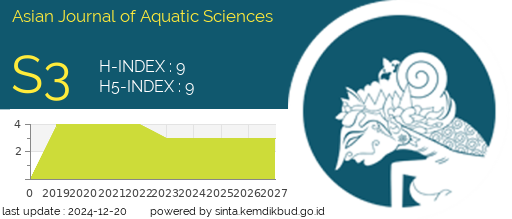BLOOD DESCRIPTION OF STRIPED CATFISH (Pangasianodon hypophthalmus) MAINTAINED BY AQUAPONIC SYSTEM AND PHOTOPERIOD MANIPULATION
DOI:
https://doi.org/10.31258/Keywords:
Striped catfish, Hematology, Photoperiod, AquaponicAbstract
Environmental conditions and nutrient input greatly affect the physiological condition of fish. The growth of Pangasianodon hypophthalmus is improved by rearing it in short photoperiod. To maintain fish health, water quality must be maintained by applying aquaponics. The application of an aquaponic system can maintain water quality. To understand the blood condition of P.hypophthalmus reared in an aquaponic system and manipulated of photoperiod has been conducted in June-August 2021. The fish was reared in a bucket of 100 L water, 30 fishes/bucket (6-8 cm TL). Treatment with aquaponics system and filters as well as 24-hour dark photoperiod and natural photoperiod. The parameters measured were the erythrocytes total, leukocytes total, hematocrit, leukocrit, and leukocyte differential of P. hypophthalmus. The result showed that in general the blood condition of the fish there was no abnormality. Differentiation leukocytes are still relatively normal. The blood condition of all fish treated were erythrocyte total was 1.76-1.85 x106 cells/mm3, leucocyte was 5.45-5.66 x104 cells/mm3, hematocrit were 21.3-37.2% and leukocrit were 0.5-1 %. Based on the data obtained, it can be concluded that with aquaponic system and manipulated photoperiod do not negatively affect the health status of fish in general.
Downloads
References
1. Setiawan, M.Y., Adriani, M., Murdjani, M. (2015). Pengaruh Fotoperiod Terhadap Aktivitas Pertumbuhan dan Kelangsungan Hidup Ikan Patin Siam (Pangasianodon hypophthalmus). Jurnal Scientiea. 5(10):27-35
2. Wahap, N., Estim, A., Kian, A.Y.S., Senoo, S., Mustafa, S. (2010). Producing organic fish and mint in an aquaponic system. Borneo Marine Research Institue, Sabah, Malaysia, 29-33
3. Lukistyowati, I., Windarti., Siregar, M.R. (2007). Analisis Hematologi Sebagai Penentu Status Kesehatan Ikan Air Tawar di Pekanbaru. Lembaga Penelitian Universitas Riau. Pekanbaru. 50 hlm
4. Emu, S. (2010). Pemanfaatan Garam pada Pengangkutan Sistem Tertutup Benih Ikan Patin (Pangasius sp) Berkepadatan Tinggi dalam Media yang Mengandung Zeolit dan Arang Aktif. Tesis. Sekolah Pascasarjana. Institut Pertanian Bogor. Bogor. 80 hlm
5. Ginting, K.D., Riauwaty, M., Syawal, H. (2021). Diferensiasi Leukosit Ikan Lele Dumbo (Clarias gariepinus) yang diberi Pakan Mengandung Kunyit (Curcuma domestica Val.) dan Diinfeksi Bakteri Aeromonas hydrophila. Jurnal Ilmu Perairan (Aquatic Science), 9(2): 116-125
6. Maftuch, M., Nursyam, H., Sukarni, S. (2012). Kajian penggunaan Ciprofloxacin terhadap hematologi ikan botia (Botia macracanthus, Bleeker) yang diinfeksi bakteri Aeromonas hydrophila. The Journal of Experimental Life Science, 2(2),pp.65-69. http://dx.doi.org/10.21776/ub.jels.2012.002.02.02
7. Klontz, G.W. (2009). Fish hematology. AceLearning Company. California. 243p
8. Nursatia., Sarjito., Haditomo, A.H.C. (2017). Pemberian Ekstrak Bawang Putih dalam Pakan sebagai Imunostimulan terhadap Kelulushidupan dan Profil Darah Ikan Patin (Pangasius sp). Journal of Aquaculture Management and Technology, 6(3) : 234-241
9. Lavabetha, A.R.R., Hidayaturrahmah., Muhamat., Budi, H.S. (2015). Profil Darah Ikan Timpakul (Periophthalmodon schlosseri) dari Muara Sungai Barito Kalimantan Selatan. Bioscientiae, 12(1): 78-89
10. Purwanti, S.C., Suminto., Sudaryono, A. (2014). Gambaran Profil Darah Ikan Lele Dumbo (Clarias gariepinus) yang Diberi Pakan dengan Kombinasi Pakan Buatan dan Cacing Tanah (Lumbricus rubellus). Journal of Aquaculture Management and Technology, 3(2): 53-60
11. Lagler, K.F., Bardach, J.E., Miller, R.R., Passiono, D.R. (1977). Ichtyology. John Wiley and Sons Inc, New York-London
12. Preanger, C., Utama, I.H., Kardena, I.M. (2016). Gambaran ulas darah ikan lele di Denpasar Bali. Indonesia Medicus Veterinus, 5(2): 96-103.
13. Santoso, B., Basuki, F., Hastuti, S. (2013). Analisa Ketahanan Tubuh Benih Hibrida Nila Larasati (Oreochromis niloticus) Generasi 5 (F5) yang Diinfeksi Bakteri S.Agalactie dengan Konsentrasi Berbeda. Journal of Aquaculture Management and Technology. 2(3): 64-75.







